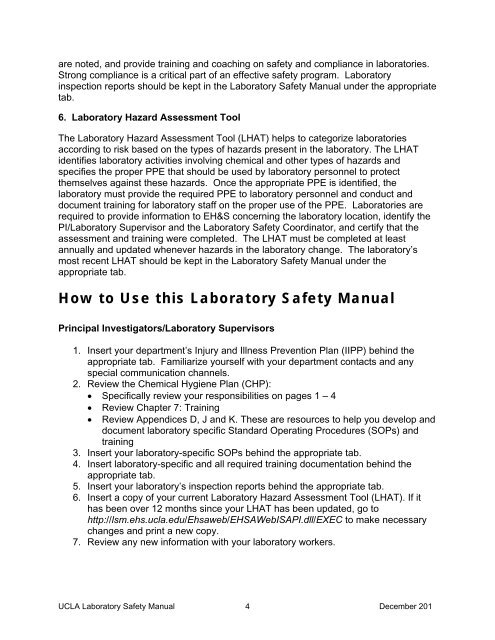Lab Safety Manual - UCLA - Environment, Health & Safety
Lab Safety Manual - UCLA - Environment, Health & Safety
Lab Safety Manual - UCLA - Environment, Health & Safety
You also want an ePaper? Increase the reach of your titles
YUMPU automatically turns print PDFs into web optimized ePapers that Google loves.
are noted, and provide training and coaching on safety and compliance in laboratories.<br />
Strong compliance is a critical part of an effective safety program. <strong>Lab</strong>oratory<br />
inspection reports should be kept in the <strong>Lab</strong>oratory <strong>Safety</strong> <strong>Manual</strong> under the appropriate<br />
tab.<br />
6. <strong>Lab</strong>oratory Hazard Assessment Tool<br />
The <strong>Lab</strong>oratory Hazard Assessment Tool (LHAT) helps to categorize laboratories<br />
according to risk based on the types of hazards present in the laboratory. The LHAT<br />
identifies laboratory activities involving chemical and other types of hazards and<br />
specifies the proper PPE that should be used by laboratory personnel to protect<br />
themselves against these hazards. Once the appropriate PPE is identified, the<br />
laboratory must provide the required PPE to laboratory personnel and conduct and<br />
document training for laboratory staff on the proper use of the PPE. <strong>Lab</strong>oratories are<br />
required to provide information to EH&S concerning the laboratory location, identify the<br />
PI/<strong>Lab</strong>oratory Supervisor and the <strong>Lab</strong>oratory <strong>Safety</strong> Coordinator, and certify that the<br />
assessment and training were completed. The LHAT must be completed at least<br />
annually and updated whenever hazards in the laboratory change. The laboratory’s<br />
most recent LHAT should be kept in the <strong>Lab</strong>oratory <strong>Safety</strong> <strong>Manual</strong> under the<br />
appropriate tab.<br />
How to Use this <strong>Lab</strong>oratory <strong>Safety</strong> <strong>Manual</strong><br />
Principal Investigators/<strong>Lab</strong>oratory Supervisors<br />
1. Insert your department’s Injury and Illness Prevention Plan (IIPP) behind the<br />
appropriate tab. Familiarize yourself with your department contacts and any<br />
special communication channels.<br />
2. Review the Chemical Hygiene Plan (CHP):<br />
Specifically review your responsibilities on pages 1 – 4<br />
Review Chapter 7: Training<br />
Review Appendices D, J and K. These are resources to help you develop and<br />
document laboratory specific Standard Operating Procedures (SOPs) and<br />
training<br />
3. Insert your laboratory-specific SOPs behind the appropriate tab.<br />
4. Insert laboratory-specific and all required training documentation behind the<br />
appropriate tab.<br />
5. Insert your laboratory’s inspection reports behind the appropriate tab.<br />
6. Insert a copy of your current <strong>Lab</strong>oratory Hazard Assessment Tool (LHAT). If it<br />
has been over 12 months since your LHAT has been updated, go to<br />
http://lsm.ehs.ucla.edu/Ehsaweb/EHSAWebISAPI.dll/EXEC to make necessary<br />
changes and print a new copy.<br />
7. Review any new information with your laboratory workers.<br />
<strong>UCLA</strong> <strong>Lab</strong>oratory <strong>Safety</strong> <strong>Manual</strong> 4 December 201
















